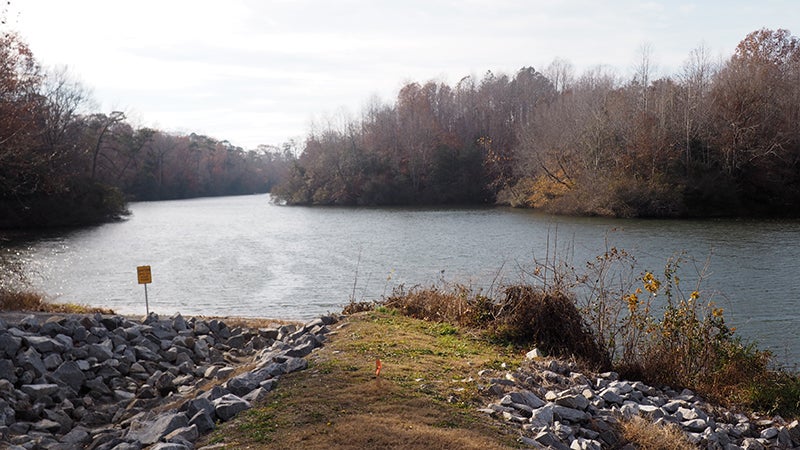Decommissioning dam could cost more than repairing it
Published 3:56 pm Tuesday, December 7, 2021

- The Smithfield Lake dam - file photo
Decommissioning the Waterworks Road dam could potentially be more costly than repairing it.
According to an engineering report by Draper Aden Associates, bringing the town-owned earthen embankment into compliance with state regulations would cost more than $1.5 million. Citing that cost, the town opted last year to forego the needed repairs, and is currently awaiting proposals to drain the 26.2-acre Smithfield Lake instead.
The report estimates demolishing a section of the embankment and installing a culvert to drain the lake could potentially be done for several hundred thousand dollars less, or might cost up to $3.2 million, depending on what, if any, environmental impact mitigations the town pursues. Draining the lake, it states, will result in an exposed lakebed where sediment has been accumulating since the dam’s construction more than a century ago.
According to the book “Historical Notes on Isle of Wight County, Virginia” by Helen Haverty King, the dam dates to 1900 when the county’s Circuit Court granted Smithfield Water Co. a charter to build and maintain a waterworks at the site, which had been an old cotton mill. The State Corporations Commission dissolved the company in 1959, at which time the dam came into the town’s possession.
Since the town transitioned to wells for its drinking water, the dam has served as a boat launch and public park. Problems with the dam began in 2010 when heavy rains weakened the structure, according to past reporting by The Smithfield Times.
The issue resurfaced in 2020 when the town needed another two-year permit from the state to continue operating the dam, and was informed the structure would need additional repairs. The dam is currently operating under a conditional permit from the state. The permit will expire in February.
Without environmental impact mitigations, the sediment trapped behind the dam will be washed downstream during future storms, the Draper Aden report warns. Mount Holly Creek, which forms the Smithfield Lake as a result of the dam, flows into the Pagan River, which is a tributary of the James River.
The James River Association, an organization that monitors and advocates for the health of the James River, isn’t necessarily opposed to the dam’s removal if proper environmental impact mitigations are implemented.
“The broader environmental community has embraced dam removal as necessary and important for healthy ecosystems,” said Ryan Walsh, lower James restoration coordinator for the Association.
Dam removal can allow migrating fish to return to historic spawning grounds, he added. Issues from sediment plumes can be temporary, “especially if this issue is considered and dealt with prior to the project,” Walsh said.
But lakebed restoration, which would involve planting native vegetation on slopes and banks to prevent sediment plumes, is what could potentially drive the cost of the dam removal to $3.2 million. According to the Draper Aden report, lakebed restoration would require $80,000 to $100,000 in professional engineering services and another $800,000 in actual construction.
Town officials haven’t said whether they plan to pursue lakebed restoration. According to Town Manager Michael Stallings, future liability on the town’s part in continuing to operate the dam factored into the Town Council’s 2020 decision to pursue its decommissioning — even with the possibility of having to spend more upfront on removing the dam than repairing it.
“While the initial cost is a factor, the cost of ongoing maintenance and repairs is a huge unknown and is a long term liability,” Stallings said.
Randolph Barlow, who owns land bordering the lake along Foursquare Road just outside the town’s borders, is hoping others will join him in opposing the dam’s removal.
“The environmental impact, what you would have to do to restore that lakebed, to me, that’s not even an option to do away with it,” Barlow said.
“It’s a picturesque lake … if you feel strongly about something and don’t speak up, it’s your own fault,” he added.
According to Stallings, what remains of the lake after the dam is decommissioned would be unusable for fishing or boating. The town hasn’t discussed plans for the old boat ramp or set a date for voting on a proposal for decommissioning the dam, he said.





